Deliverables and outcomes
Deliverables
As a relatively new crop in Canada, soybean has expanded to become the third most important crop after wheat and canola, generating annual revenues exceeding 2.5B$, much of the recent expansion has taken place in Western Canada. As can be expected, however, this rapid expansion has given rise to important new challenges.
Improving yield in very early maturing soybeans to help fuel and support the continued expansion of the crop in Canada is needed. It also remains important gaps in research with regards to diseases/pests. Firstly, one has to know the enemy: which species are present and what specific races or pathotypes is present in growers’ fields? This is crucial in terms of decision-making process to choose the soybean varieties to grow. Secondly, it is necessary to identify genes and to develop DNA markers to help breeders rapidly develop new varieties.
We believe future growth will hinge on the availability of high yielding and early maturing soybean varieties adapted to the very short growing seasons in these areas. Another challenge will be to develop disease-resistant varieties that withstand the attacks of various pathogens and pests. Finally, in the particular context of a large potential expansion of the crop in Western Canada, additional challenges are being faced in terms of crop adoption and sustainability. This project aims to address these major challenges by exploiting genomic tools.
Deliverable 1. High-throughput, low-cost SNP genotyping platform
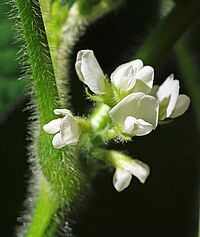
Until the advent of the latest sequencing technologies and their derivatives in the area of genotyping, the generation of DNA marker information was extremely challenging and costly to obtain for most breeders. Genomics is now revolutionizing the way in which this can be done. We propose to make these technologies available to breeders in the form of an external service and to deliver the needed information at a low cost. Essentially, a breeder would simply send samples to a genotyping platform and would receive his/her data within a few weeks. This information would then be used by breeders to help them breed better soybeans either by helping them choose the most appropriate soybean lines to cross together or by guiding them in the choice of the most promising lines.
Deliverable 2. Selection tools (both markers and a predictive model) to enable breeders to more rapidly select lines with improved yield and disease resistance in short-season soybean
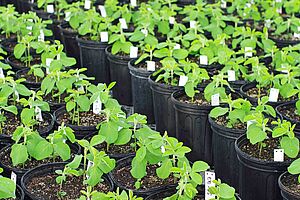
For some traits, simply looking at a plant will tell you if it is tall or short. But for many traits of the greatest interest to growers, such as yield and disease resistance, it is not so. In fact, it can be quite long and costly to perform a large number of field trials to characterize the attributes of a given soybean line. The tools we will develop will be of two sorts: 1) DNA markers providing immediate and relevant information as to whether or not a given line carries a specific gene conferring resistance to a disease or pest; and 2) a statistical model that, based solely on the genetic makeup of a plant, will accurately predict how it will perform in the field for such complex traits such as yield. Basically, this will allow breeders to directly probe a plants genetic composition to determine if it has the appropriate genes to be high yielding and to be protected from dangerous pests. These tools will then be used by breeders to develop improved varieties.
Deliverable 3. Diagnostic tools to identify the presence and pathotypes of P. sojae and H. glycines in Canadian soybean fields

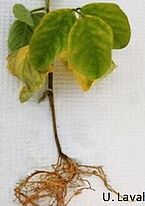
It is now possible to develop primers that are highly specific to individual strains within a fungal species and use genomics (multiplex PCR) approaches to discriminate among these individuals within complex samples. This represents the basis of the diagnostic tools to be developed for identifying the presence and the specific pathotypes of both P. sojae and H. glycines. This deliverable will take the form of a simple PCR test. This tool will be extremely useful to breeders and growers in decision-making when it comes to variety selection and in reducing losses to these major pathogens. A breeder will be in a position to make a specific recommendation of resistant varieties to growers based on the precise knowledge of the pathotypes that are present in the grower’s fields. In addition, if a grower experiences problems with P. sojae or H. glycines, he/she will be able to send a sample of diseased material to the diagnostic lab to obtain a rapid and precise diagnosis of the pathogen/pathotype affecting the crop. Better management decisions will be implemented for the next years to make sure that the genetic material used confers resistance to the pathotypes present in the grower's field is used.
Deliverable 4. Geographic map of the distribution of Phytophthora sojae and its specific pathotypes (races) throughout the soybean production areas in Canada
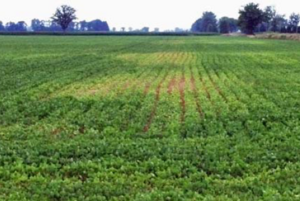
We want to provide breeders and growers with a precise characterization of the distribution of specific pathotypes of P. sojae present throughout soybean production areas in Canada. After a systematic sampling of the soybean growing areas in Canada (thanks to our partners in the seed industry), we will use the diagnostic tools described in Deliverable 3 to produce a comprehensive map of the presence and distribution of P. sojae. This map will: 1) alert growers to the presence of P. sojae and serve as a tool to plant material resistant to the pathotypes present; 2) serve as a reference tool for breeders to guide the development and release of soybean varieties resistant to P. sojae; 3) serve as a dynamic reference to delineate the evolution of P. sojae pathotypes in Canada and help breeders and growers to adapt if and when these pests evolve.
Deliverable 5. A data-informed outreach strategy targeted toward accelerated producer adoption of soybeans in Canada.
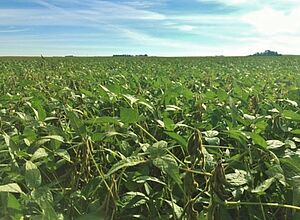
This deliverable recognises that innovation only occurs with a change in practice, and that adoption by each producer is a complex decision. The Soybean Solution Networks will explicitly identify barriers to adoption, which will be verified and supplemented by a survey of producers. By engaging producers, agronomic consultants and public extension specialists in the research process, and in the design of better extension tools, the producer knowledge gaps will be better addressed. This will speed the adoption process. The accelerated adoption of soybeans will create widespread benefits including increased profitability and reduced nitrogen fertilizer use. By extending the cropping options, producers will also have more tools to manage crop diseases and the herbicide resistance of weeds.
